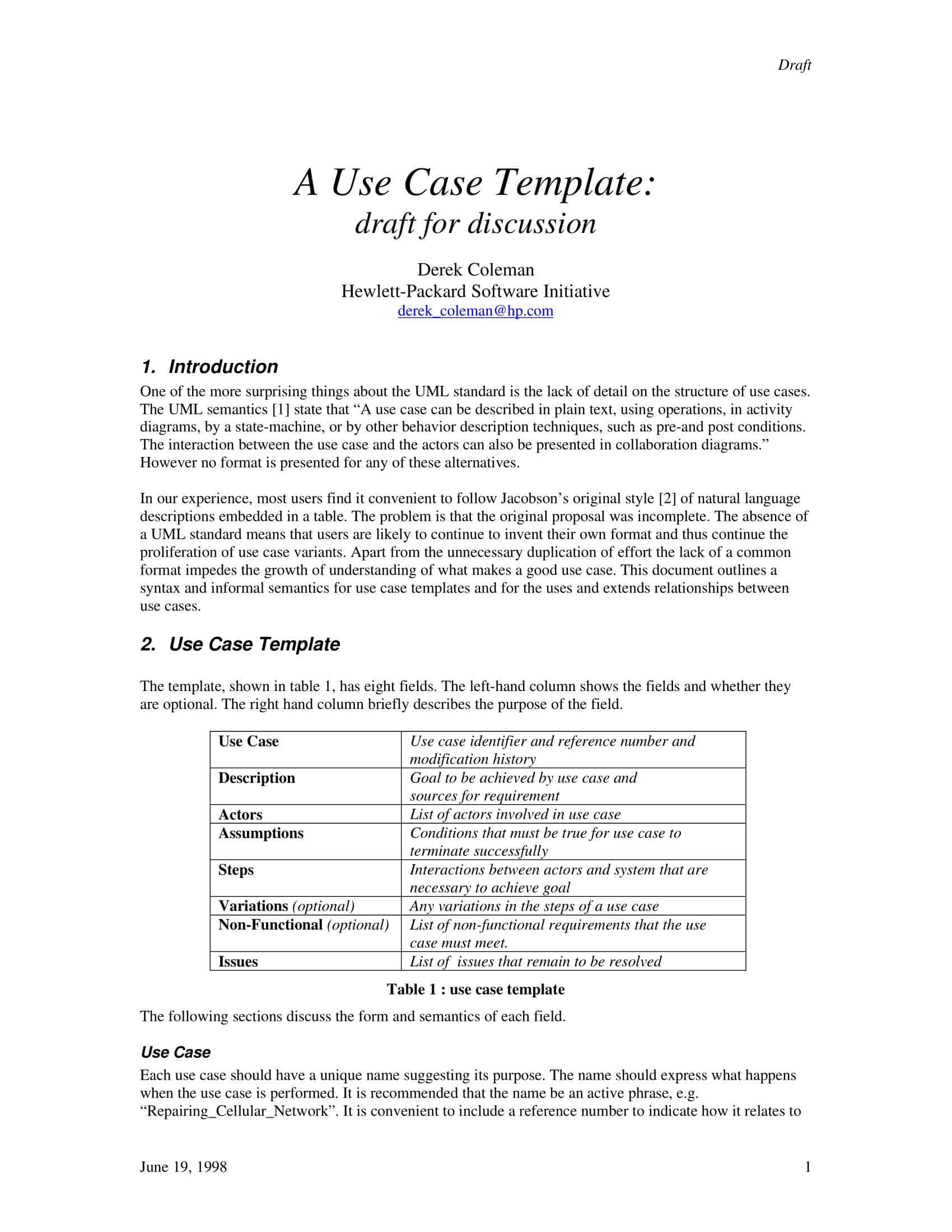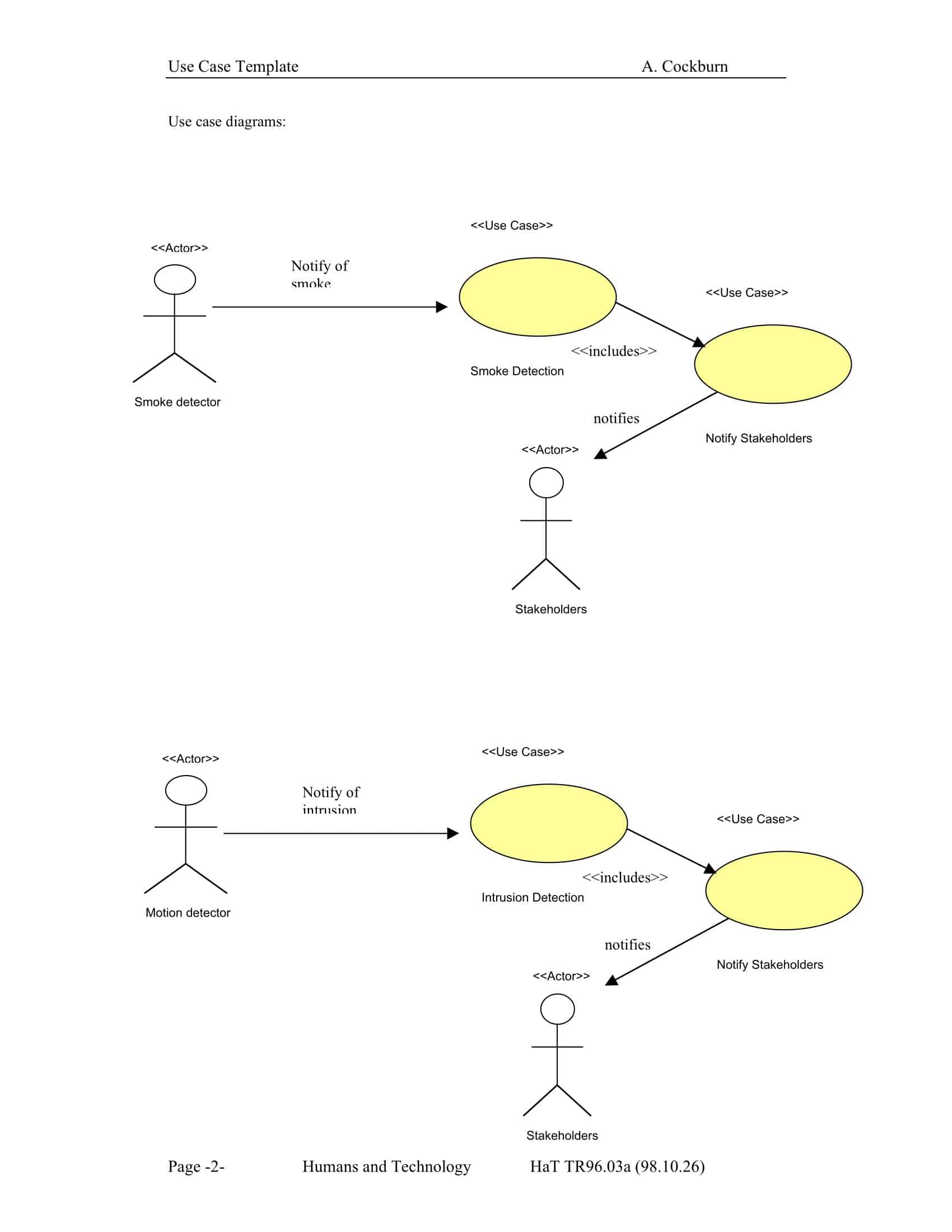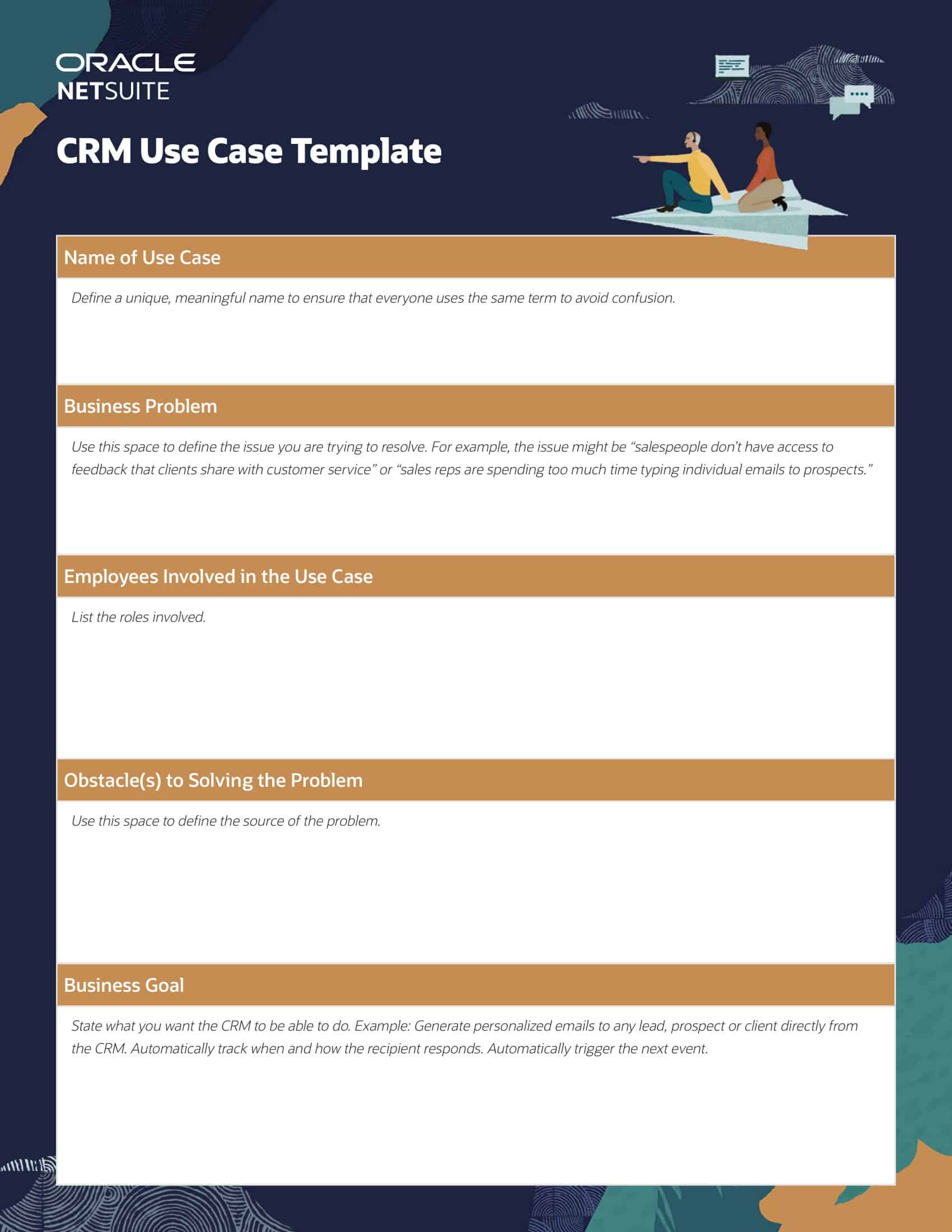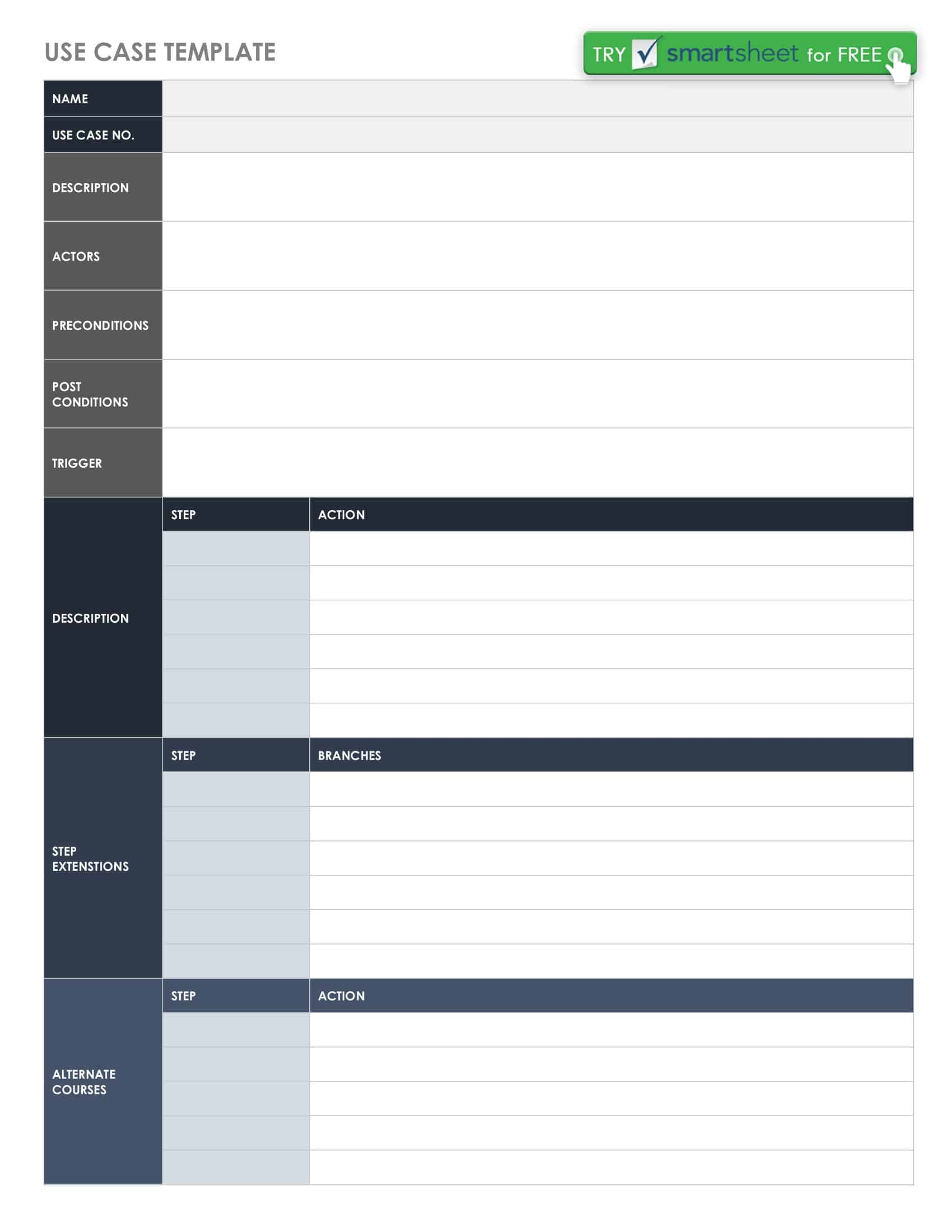A user case is a concept utilized in system engineering, application development, and various disciplines to illustrate the potential ways a system can be employed to accomplish particular objectives or activities. It delineates the interactions between users or participants and the system, resulting in a desired outcome.
In this article, we will delve into the intricacies of user scenarios, their application in system engineering, and the advantages they offer. Additionally, we will examine common user scenario categories and share guidance on constructing effective user scenarios.
Furthermore, to assist you in efficiently managing your project’s user scenarios, we will introduce a ready-to-use requirements management template that will enable you to collect all essential data and ensure that all stakeholders are on the same page regarding the project’s aims.
Table of Contents
Use Case Templates
Streamline software development and enhance communication with our comprehensive collection of Use Case Templates. A use case is a technique used in software development to capture functional requirements and describe the interactions between users (actors) and a system. Our customizable and printable templates provide a structured framework for documenting and visualizing use cases, including actors, system behavior, and desired outcomes.
Whether you’re a software developer, project manager, or business analyst, our templates cover essential sections such as use case descriptions, preconditions, postconditions, and alternative flows. By utilizing our Use Case Templates, you can ensure clarity, consensus, and alignment among stakeholders, improve development efficiency, and enhance the quality of your software solutions. With visually appealing designs and user-friendly layouts, our templates make it easier to capture and communicate complex software requirements. Streamline your software development process, reduce misunderstandings, and deliver successful software projects with our user-friendly templates. Download now and unlock the power of effective use case documentation in your software development endeavors.
What is a use case?

A use case is a concept used in system design, software development, and other fields to describe a specific situation in which a system or application interacts with users (actors) to achieve a particular goal or complete a specific task. Use cases help define the functional requirements of a system by outlining the steps and interactions between the actors and the system itself. They serve as a valuable tool for communicating and understanding how the system should behave, ultimately helping developers and stakeholders to design and implement a solution that meets the users’ needs.
What are the benefits of use cases?
Use cases offer several benefits in system design and software development, including:
Clear communication: Use cases help clearly communicate functional requirements and expected system behavior to developers, stakeholders, and end-users. They provide a common language that can be easily understood by both technical and non-technical team members.
Improved user experience: By focusing on user interactions and goals, use cases help ensure that the system is designed to meet the needs of the end-users, ultimately resulting in a better user experience.
Simplified requirement analysis: Use cases help break down complex processes and system behavior into manageable steps, making it easier to identify and analyze requirements.
Traceability: Use cases provide a traceable link between requirements and design elements, ensuring that all requirements are addressed during the development process and simplifying validation and verification efforts.
Better system testing: Use cases can be used to develop test scenarios and test cases, helping to ensure that the system functions as expected and meets the defined requirements.
Enhanced collaboration: Use cases facilitate collaboration among team members by providing a clear understanding of the system’s functional requirements and allowing for discussion and feedback.
Reduced development risks: By providing a clear understanding of the system’s requirements and expected behavior, use cases help to identify potential issues or gaps early in the development process, reducing the risks associated with redesign or rework.
Easier maintenance and updates: Well-documented use cases can serve as a reference point for future updates or modifications, making it easier to understand the impact of changes on the system and reducing the effort required for maintenance.
Overall, the use of use cases in system design and software development can lead to a more efficient development process, improved communication among team members, and a higher quality end product that meets the needs of its users.
Elements you should include in use cases
Use cases are comprised of several components that together provide a comprehensive description of the interactions between users and the system. Here is an explanation of the main components included in use cases:
Use Case Name: The use case name is a concise, descriptive title that identifies the specific user goal or functionality the use case represents. It should be written in a clear, action-oriented manner that is easily understood by both technical and non-technical stakeholders.
Actors: Actors are the entities that interact with the system to achieve a specific goal. They can be human users, other systems, or external components. Clearly identifying the actors helps to define the scope and boundaries of the use case.
Preconditions: Preconditions are the conditions that must be met before the use case can be executed. They help to set the context and ensure that the system is in the correct state for the use case to begin.
Postconditions: Postconditions describe the state of the system after the use case has been successfully executed. They define the expected outcome of the use case and help to validate whether the system’s behavior aligns with the desired functionality.
Main Success Scenario: The main success scenario, also known as the basic flow, outlines the sequence of steps and interactions between the actors and the system that lead to a successful completion of the use case. The main success scenario should be written in a clear, step-by-step format that is easy to understand and follow.
Alternative Flows: Alternative flows, also known as extensions or exception flows, describe variations or exceptions to the main success scenario. They account for different ways the system can behave or respond to unexpected situations, errors, or alternative paths the user may take. Including alternative flows helps to ensure that the use case is robust and adaptable to various scenarios.
Trigger: The trigger is the event or condition that initiates the use case. It can be a user action, a system event, or a specific condition that is met. Identifying the trigger helps to define when the use case should be executed and how it fits within the overall system workflow.
Priority: The priority of a use case helps to indicate its relative importance within the project. Prioritizing use cases can assist in project planning and resource allocation by highlighting which use cases are critical and should be addressed first.
Use Case Formats
There are several formats that can be used to document and present use cases, each offering different levels of detail and complexity. Choosing the appropriate format depends on the project’s requirements, the audience, and the team’s preferences. Here are some common use case formats:
Narrative (Textual) Format: The narrative format is a text-based description of the use case, outlining the components such as actors, preconditions, postconditions, main success scenario, alternative flows, and triggers in a structured, written format. This format is widely used due to its simplicity and ease of understanding by both technical and non-technical stakeholders.
Example:
- Use Case: Withdraw Cash from ATM
- Actor: Bank Customer
- Preconditions: Bank Customer has a valid ATM card and PIN
- Postconditions: Bank Customer receives the requested cash and updated account balance
Main Success Scenario:
- Bank Customer inserts ATM card
- ATM prompts for PIN
- Bank Customer enters PIN
- ATM validates PIN
- Bank Customer selects “Withdraw Cash” option
- Bank Customer enters withdrawal amount
- ATM dispenses cash and updates account balance
Use Case Diagrams: Use case diagrams are visual representations of use cases, using the Unified Modeling Language (UML) notation. They show the actors, use cases, and the relationships between them, providing a high-level overview of the system’s functionality. Use case diagrams are often used in conjunction with textual descriptions to provide a more complete representation of the use cases.
Example:
[Bank Customer] —(Withdraw Cash)— [ATM]
Use Case Templates: Use case templates are standardized documents with pre-defined sections for each use case component. They help to ensure consistency and completeness in documenting use cases across a project. Templates can be created in various formats, such as Word documents, Excel spreadsheets, or specialized requirements management tools.
Example:
- Use Case Name: Withdraw Cash from ATM
- Actor: Bank Customer
- Preconditions: Bank Customer has a valid ATM card and PIN
- Postconditions: Bank Customer receives the requested cash and updated account balance
- Main Success Scenario: (List steps as above)
- Alternative Flows: (List alternative flows)
- Trigger: Insertion of ATM card
- Priority: High
User Stories: User stories are a more informal and agile approach to capturing use cases. They are written from the perspective of the user and describe a specific functionality or feature using a simple and concise format. User stories can be a good starting point for more detailed use case documentation, especially in projects that follow agile methodologies.
Example:
As a bank customer, I want to withdraw cash from an ATM so that I can access my money.
Each of these use case formats has its advantages and disadvantages, and the most suitable format will depend on the project’s context, the team’s preferences, and the desired level of detail. Using a combination of formats, such as textual descriptions with use case diagrams or templates, can provide a comprehensive representation of use cases and ensure that all stakeholders have a clear understanding of the system’s functional requirements.
Creating a Use Case Diagram: (Step by Step Guide)
Use case diagrams are visual representations of how a system interacts with its users (actors) to perform specific tasks. They are a crucial part of the Unified Modeling Language (UML) for designing and documenting software systems. Follow these steps to create a use case diagram:
Step 1: Identify the System Scope
Before creating the use case diagram, you must first define the scope of the system you are designing. Determine the system boundaries and what it aims to achieve.
Example: Let’s consider designing a Library Management System (LMS). The scope of the system includes managing books, users, and the borrowing process.
Step 2: Identify Actors
Actors are the entities that interact with the system. They can be users, other systems, or external entities. List all the actors involved in the system.
Example: In our LMS, actors can include:
- Librarian
- Member
- External Book Supplier
Step 3: Identify Use Cases
Use cases represent the specific tasks or functions the system performs in response to the actors’ interactions. Brainstorm and list all the significant use cases.
Example: For the LMS, some use cases might include:
- Add Book
- Remove Book
- Register Member
- Borrow Book
- Return Book
- Search Book
- Generate Reports
- Order Books from Supplier
Step 4: Describe Use Cases
For each use case, provide a brief description of the functionality and the steps involved in completing the task.
Example: For the “Borrow Book” use case in the LMS:
- The member searches for a book.
- The member selects the book to borrow.
- The system checks the member’s eligibility to borrow the book.
- The system registers the book as borrowed by the member.
- The system updates the book’s availability status.
Step 5: Organize Use Cases
Group related use cases together to create a more structured diagram. This can help in understanding the system’s functionality more effectively.
Example: In the LMS, use cases can be organized into:
- Book Management: Add Book, Remove Book, Search Book, Order Books from Supplier
- Member Management: Register Member
- Borrowing Process: Borrow Book, Return Book
- Reporting: Generate Reports
Step 6: Draw the Use Case Diagram
Using a UML tool or any drawing software, create the use case diagram by following these guidelines:
- Draw a rectangle representing the system boundary and label it with the system’s name.
- Place actors outside the system boundary and use stick figures or icons to represent them.
- Place use cases inside the system boundary and represent them with ovals.
- Connect actors to the use cases they interact with using lines.
Example: For the LMS, the use case diagram would have the system boundary labeled “Library Management System,” actors like Librarian, Member, and External Book Supplier outside the boundary, and use cases like Add Book, Borrow Book, etc., inside the boundary.
Step 7: Review and Refine
Review the use case diagram with stakeholders and refine it based on their feedback. This iterative process helps ensure the diagram accurately represents the system’s requirements.
Example: After presenting the LMS use case diagram to stakeholders, you may need to add, remove, or modify use cases based on their suggestions.
Use case diagram example
Here are three comprehensive examples of use case diagrams for different systems:
Online Shopping System
Actors:
- Customer
- Seller
- Payment Gateway
- Shipping Company
Use Cases:
- Register Customer
- Login
- Browse Products
- Search Products
- Add Product to Cart
- Remove Product from Cart
- Update Cart Quantity
- Checkout
- Apply Discount Code
- Make Payment
- Cancel Order
- View Order History
- Manage Inventory
- Update Product Information
- Ship Order
- Confirm Delivery
- Process Refund
- Hospital Management System
Actors:
- Patient
- Doctor
- Nurse
- Receptionist
- Pharmacist
- Laboratory Technician
- Billing Staff
Use Cases:
- Register Patient
- Schedule Appointment
- Update Patient Information
- Access Patient Medical Records
- Add Prescription
- View Prescription
- Update Prescription
- Manage Inventory
- Dispense Medication
- Create Lab Test Request
- Perform Lab Test
- View Lab Test Results
- Update Lab Test Results
- Create Invoice
- Process Payment
- Generate Reports
- ATM (Automated Teller Machine) System
Actors:
- Bank Customer
- Bank
- Maintenance Staff
Use Cases:
- Insert Card
- Enter PIN
- Check Account Balance
- Withdraw Cash
- Deposit Cash
- Deposit Check
- Transfer Funds
- Print Mini-Statement
- Change PIN
- View Transaction History
- Report Lost or Stolen Card
- Check ATM Cash Levels
- Refill Cash
- Perform Maintenance
These examples demonstrate different use case diagrams, each with its unique set of actors and use cases. For each system, you would follow the steps outlined in the previous response to create a comprehensive use case diagram.
FAQs
When should I use a use case diagram?
Use case diagrams are useful during the early stages of a software development project. They help identify system requirements, clarify the system’s scope, and facilitate communication among stakeholders. Use case diagrams are particularly beneficial when designing complex systems with multiple actors and interactions.
How detailed should a use case diagram be?
A use case diagram should be detailed enough to provide a clear understanding of the system’s functionality and actor interactions. However, it should not be overly detailed to avoid clutter and confusion. The primary goal is to convey the system’s main features and interactions in a clear and concise manner. More complex or detailed information can be provided through supplementary documentation, such as textual descriptions of use cases.
Can a use case have multiple actors?
Yes, a use case can have multiple actors interacting with it. This typically occurs when different actors need to perform the same task or function within the system. In a use case diagram, you can represent this by connecting multiple actors to the same use case using lines.
What is the difference between a use case and a user story?
A use case is a detailed description of a system’s functionality, including the steps required to complete a task and the interactions between actors and the system. A use case diagram is a visual representation of these use cases.
A user story, on the other hand, is a brief, informal description of a software feature from the perspective of an end-user. It usually follows the format: “As a [user role], I want [goal] so that [reason].” User stories are commonly used in Agile development methodologies to define and prioritize features based on user needs.
While both use cases and user stories focus on user needs and system functionality, use cases are more formal and detailed, whereas user stories are brief and high-level.
What is an actor in a use case diagram?
An actor in a use case diagram represents a user, external system, or entity that interacts with the system being modeled. Actors can initiate use cases or participate in them. In a use case diagram, actors are typically represented by stick figures or icons placed outside the system boundary.
What is the difference between an actor and a use case?
An actor represents a user, external system, or entity that interacts with the system being modeled. A use case, on the other hand, is a specific task or function that the system performs in response to an actor’s interaction. In a use case diagram, actors initiate or participate in use cases, which describe the system’s functionality.
Can an actor be another system?
Yes, an actor can be another system. When an external system interacts with the system being modeled, it is represented as an actor in the use case diagram. This can help demonstrate dependencies or integrations between different systems.
What is an extend relationship in a use case diagram?
An extend relationship in a use case diagram indicates that the behavior of one use case (the extending use case) can be extended by another use case (the extended use case) under certain conditions. The extend relationship is represented by a dashed arrow with an open arrowhead pointing from the extending use case to the extended use case, and is usually labeled with the keyword “extend.”
What is an include relationship in a use case diagram?
An include relationship in a use case diagram indicates that the behavior of one use case (the base use case) includes the behavior of another use case (the included use case) as a part of its flow. This relationship is used to show reuse or modularity in a system. The include relationship is represented by a dashed arrow with an open arrowhead pointing from the base use case to the included use case, and is usually labeled with the keyword “include.”
Can a use case diagram show the flow of control or sequence of events?
A use case diagram focuses on the relationships between actors and use cases, and does not explicitly show the flow of control or sequence of events within a use case. To represent the flow of control or sequence of events, you can use other UML diagrams, such as sequence diagrams or activity diagrams.
Can a use case diagram represent data flow?
A use case diagram does not directly represent data flow. Its primary purpose is to show the interactions between actors and use cases in a system. If you need to represent data flow, consider using a data flow diagram (DFD) or another suitable modeling technique.
Is a use case diagram necessary for every project?
The necessity of a use case diagram depends on the complexity of the project, the development methodology being used, and the preferences of the project stakeholders. Use case diagrams can be particularly helpful in projects with multiple actors and complex interactions, as they provide a clear visual representation of the system’s functionality. However, not every project requires a use case diagram, and other modeling techniques or documentation methods may be more suitable for certain projects.
What is the purpose of a use case diagram?
Use case diagrams serve several purposes, including:
- Defining and visualizing the system’s functionality and scope.
- Identifying system requirements and the interactions between actors and the system.
- Communicating system behavior to stakeholders, developers, and testers.
- Facilitating the analysis and design of a system.


































































![Free Printable Credit Card Authorization Form Templates [PDF, Word, Excel] 1 Credit Card Authorization Form](https://www.typecalendar.com/wp-content/uploads/2023/06/Credit-Card-Authorization-Form-150x150.jpg)
![Free Printable Stock Ledger Templates [Excel,PDF, Word] 2 Stock Ledger](https://www.typecalendar.com/wp-content/uploads/2023/08/Stock-Ledger-150x150.jpg)
![Free Printable Financial Projections Templates [Excel, PDF] 3 Financial Projection](https://www.typecalendar.com/wp-content/uploads/2023/05/Financial-Projection-1-150x150.jpg)
